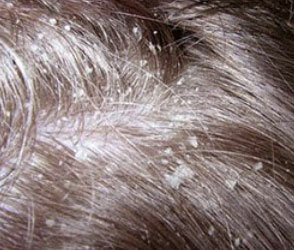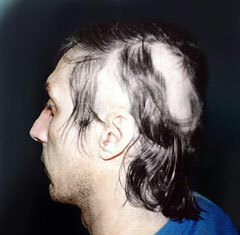Alopecia is called total or partial loss of hair due to the effects of endogenous (internal) or exogenous (external) factors. Alopecia areata in men is one of the varieties of the nature of dermatological pathologies. The earliest symptom, determining the presence of the pocket (focal) form of hair loss, is the appearance of a small area on the head, hair devoid of coating.

- local form of alopecia characterized by small areas of the head without the presence of the hair coat with clearly defined edges;
- diffuse causes quite intense hair loss from all over the head, that is, small plots are merged to form a large bald patch;
- subtotal says the loss of hair up to 40-45%;
- total covers the entire surface and leads to a complete loss of hair;
- Universal is quite rare, but characterized by the lack of hair on the whole body, including eyebrows, eyelashes perineum area, underarms, upper and lower limbs.
Step clinical course of alopecia areata
Experts distinguish several stages of flow alopecia areata. Each stage has its own clinical signs. Determination of the running process is as follows:- active stage causes the presence in patients of symptoms such as redness, swelling, burning sensation, and itching at the site of formation of alopecia, hair easily separated from the head surface at the slightest contact or effects;
- Stationary phase is characterized by a pale spot without a hair, but with normal hair root at the border and stored follicles lost hair;
- remission stage causes the appearance of hair loss at the site of vellus hair with reduced pigmentation.
Causal factors of alopecia
The etiology of hair loss is not fully understood, so the cause of alopecia areata male experts believe that the following factors:- Genetic predisposition and heredity;
- hypo, hyper or vitamin deficiency;
- hormonal aspect causes hair loss due to increased production of sex hormone (DHT), which is called the androgenic type alopecia areata, diagnosed in 90% cases;
- infectious and viral diseases which are of a chronic nature;
- diseases of the digestive tract;
- a birth defect of the hair follicle, which is usually diagnosed in the first 1-2 years of life;
- metabolic disorders (diabetes, obesity, dystrophy);
- close contact with the chemical and radioactive substances;
- severe stress or permanent psycho-emotional overload;
- abuse or forced medication, particularly applicable in the treatment of cancer (chemotherapy);
- bad habits, too, are included in the list of possible negative influencing factors;
- improper feeding to the presence of large amounts of chemicals and carcinogens;
- autoimmune process is considered the most probable cause of alopecia areata in men.
Features of the development of androgenic form
Experts distinguish several main reasons for the development of androgenic form of hair loss in men, namely, the following:- very high sensitivity of hair follicles to the hormone dihydrotestosterone;
- levels of the male hormone significantly exceeds the acceptable rate;
- high activity of a certain enzyme, which causes the conversion of testosterone to dihydrotestosterone, a negative impact on the hair follicle.

Thus, in a universal form of alopecia, the owner of the male genome could lose eyebrows, eyelashes and beard.
Baldness typically begins with the edge of the frontal lobe and gradually reaches the parietal region. The hair structure more resistant to dihydrotestosterone in the back of the head, which can be seen in most of the hairstyles in men aged 50-60 years. Described several stages of disease progression in men with androgenetic alopecia forms.Trichologists noted gradual hair loss that looks like this:
- the formation of small bald patches on the edge of the forehead;
- baldness extends toward the top;
- hair in the frontal lobe significantly thinning with the transition to the crown;
- balding areas are clearly marked out in the frontal and parietal regions;
- boundary between the lubricated gradually, forming a total area;
- baldness gets a clear shape of a horseshoe.
Methods and principles of diagnostic measures
To see a doctor, the patient is subject to a careful visual inspection specialist for areas with a lack of hair. Specialist scrupulously collects personal history, focusing on the relatives in the male line with the presence of such problems. Figuring out when and under what circumstances, have begun to actively losing his hair on his head. Based on the collected data the doctor appoints a number of additional tests to differentiate and clarify the diagnosis. In most cases, the cause of alopecia areata is specified through such activities:- detailed analysis of the peripheral blood;
- Renal-hepatic complex provides information on the internal organs;
- US parenchymal organs;
- blood test for hormones;
- analysis of thyroid hormones;
- immunogram;
- analyzed for TORCH-infection;
- taking the material for histological examination (hair, skin lesion).
Therapeutic interventions in the treatment of alopecia areata
In today's world there is still no specific methodology to solve the problem of alopecia once and for all. The disease is very insidious and to predict its course, remission and relapse is practically impossible. Specialists conducted a series of therapeutic measures aimed at eliminating the causes of alopecia and symptomatic treatment is topical administration. Difficulty in the management of patients with a diagnosis of alopecia areata is that, for unknown reasons, the pathology can manifest the formation of new areas of bald head against adequate and effective therapy in relation to existing homes baldness.It described many cases where patients with total or universal form of alopecia observed partial, and in some cases, a full recovery of hair without medical intervention.
However, as noted situations in which a total of alopecia areata on the head of the men there and malignant form of progressing against the background of well-being, not in response to the sighting therapy. Usually trichologists by adjacent specialists consultations, used to treat alopecia number of the following activities:- hormone therapy, which involves administering glucocorticoid prednisolone;
- recovery and regulation of hormonal male relative of sex hormones, ie, therapeutic actions are aimed at decrease in testosterone or dihydrotestosterone transition in shape, which in most cases becomes total culprit alopecia;
- local procedures to restore hair revitalizing and directed to the stimulation of hair follicle using ointments, lotions and gels for rubbing into the scalp, based on red pepper, mustard, castor oil and camphor, which have irritating action;
- correction of immunity in many cases gives a positive result in every second man for the treatment of alopecia areata;
- well established physiotherapeutic methods such as darsonvalization, massage effect melkotochechnye currents developing area alopecia;
- menu composing for the normalization of proper nutrition with the use of a large number of vitamins, minerals, proteins and essential amino acids, which play an important role in the normal life of the hair bulb.
Found a bug? Select it and press Ctrl + Enter



